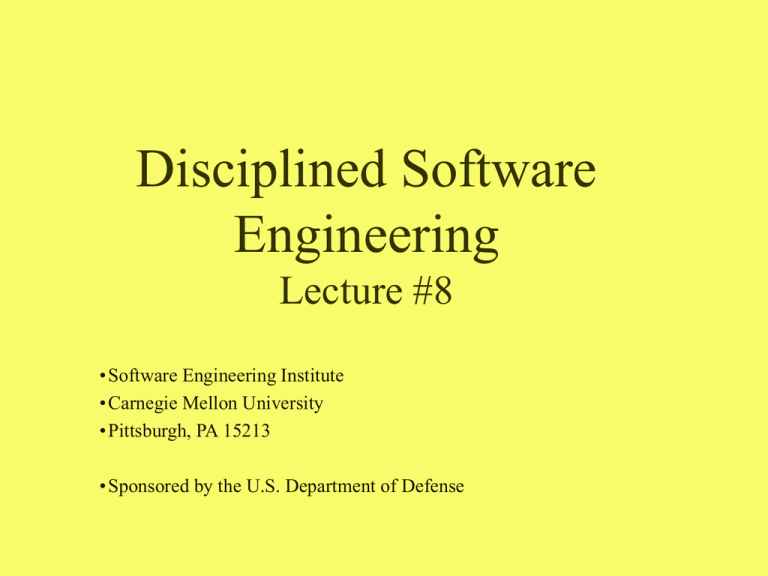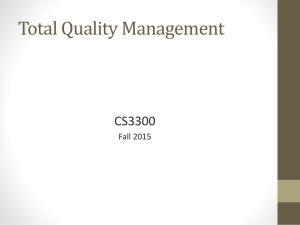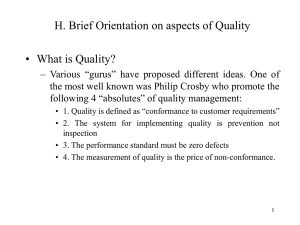Lect898
advertisement

Disciplined Software Engineering Lecture #8 • Software Engineering Institute • Carnegie Mellon University • Pittsburgh, PA 15213 • Sponsored by the U.S. Department of Defense Lecture Overview •What is quality? –product and process quality –quality economics •The quality strategy –characterizing a process –benchmarking a process •Yield management –defect removal –defect prevention What is Software Quality? •Basic definition –meeting the users’ needs –needs, not wants –true functional needs are often unknowable •There is a hierarchy of needs –do the required tasks –meet performance requirements –be usable and convenient –be economical and timely –be dependable and reliable Dependable and Reliable •To be used, the software must –install quickly and easily –run consistently –properly handle normal and abnormal cases –not do destructive or unexpected things –be essentially bug free •The latent bugs must –be operationally insignificant –not be destructive –rarely be evident A Quality Process •Produces quality products •Meets its users needs •You are the user of the PSP process •Your customers are your –management –peers and associates –product’s users The PSP Quality Focus - 1 •In this course defects are the basic quality measure. •Note that bugs are not important to the user as long as they do not –affect operations –cause inconvenience –cost time or money –cause loss of confidence in the program’s results The PSP Quality Focus - 2 •The defect content of software products must first be managed before other more important quality issues can be addressed. •Current software processes manage defects so poorly that little if any time is available for such important software quality issues as –installability –safety –performance –recovery –usability, etc. The PSP Quality Focus - 3 •Low defect content is an essential prerequisite to a quality software process. •Low defect content can best be achieved at the PSP level. •This is where the defects are injected and this is where the engineers should –remove them –determine their causes –learn to prevent them Tests and Inspections - 1 •Without inspections and a 50,000 LOC system –25+ defects/KLOC at test entry –that is 1250 defects –at the typical 10+ hours per defect, that is 12,500+ programmer hours –that is 6 programmer years •If properly planned, these tests could be done in 12 to 15 months. •If unplanned, testing could take two years or more. Tests and Inspections - 2 •With inspections and a 50,000 LOC system –inspections take about 10 programmer hours per 250 LOC, or about 2,000 hours –this is 1 programmer year –if done well, inspections can remove about 80% of the defects •This means, 250 defects would be left for test –this would take about 2,500 hours –or a saving of 8,000 hours –or a saving of 4 programmer years Tests and Inspections - 3 •With the PSP –code quality will be sharply improved –several thousand hours could probably be saved •Inspection should still be done –the inspection focus should be on design •The principal advantages are –improved product quality –a more predictable schedule –time to focus on the important quality issues Some Fix Time Data •Some typical fix time ratios –IBM rules of thumb: coding - 1.5; testing - 60; usage - 100 –Boehm: design - 1; development test - 15 to 40; acceptance test - 30 to 70; operation - 40 to 1000 –Remus: design - 1, code - 20, test - 82 –Ackerman: test 2 - 10 times inspection time –Russell: inspection - 1, test - 2 to 4, use - 33 –PSP research: unit test takes 12 times longer than code review to find and fix defects The Cost of Quality (COQ) - 1 •COQ is a way to measure process quality. •COQ has the following components –failure costs –appraisal costs –prevention costs The Cost of Quality (COQ) - 2 •Failure costs –repair, rework, and scrap –in PSP, failure costs include all compile and test time •Appraisal costs –costs of inspecting for defects –in PSP, appraisal costs include all design and code review time The Cost of Quality (COQ) - 3 •Prevention costs –finding and resolving defect causes –generally handled before projects start –should typically be a process and not a project activity •In the PSP, examples of prevention costs are –formal specification or design work –prototyping –process analysis and improvement The Cost of Quality (COQ) - 4 •A useful COQ measure is the ratio of appraisal to failure costs (A/FR). This is –100*(appraisal COQ)/(failure COQ) •A/FR experience –the A/FR measure is not widely used –if measured, most software organizations would be near zero –in the PSP, A/FR should exceed 2.0 –high A/FR is associated with low numbers of test defects and high product quality The Quality Strategy - 1 •Identify your PSP quality objectives, i.e. –removing all defects before the first compile –achieving high productivity –producing accurate plans •Establish PSP process quality measures, i.e. –overall process yield –COQ appraisal vs. failure costs - A/FR –LOC reviewed per hour –Cost performance index - CPI The Quality Strategy - 2 •Examine the projects you have completed –determine their ratings on these measures –see what behaviors impacted these results •Based on these data, identify the most effective practices for your work. •Incorporate these practices in your process –process scripts –checklists –forms The Quality Strategy - 3 •Identify measures that will reasonably predict process quality –establish these as control variables –set specifications for these variables •Track your performance against these specifications. •Track your process to determine –if and when to change the specifications –actions to take to improve the process further Process Benchmarking •A method for tracking process improvement should –consider quality and productivity –provide means for comparing process used by different people or organizations –be insensitive to project specifics •Industrial process benchmarking typically deals with the ability of the process to –produce products within specifications –withstand drift and perturbation Software Benchmarking •At present, software benchmarking techniques are process dependant. •They are still useful, however as long as we –establish objective measures –track them over time –use them for improving the process for which they are designed •Comparisons should not be made among individuals or organizations using process sensitive benchmarks. Using Software Benchmarks •Establish a consistent set of measures for evaluating your process performance –take these measures on every project –compare individual projects to determine trends or problems •Establish and track short-term improvement goals against these measures. •Establish and track long-term improvement goals against these measures. Benchmarking Data •The following data are from various of the students in the PSP course at Carnegie Mellon University in the Spring of 1994. •The data are –yield by project –yield vs A/FR –A/FR vs test defects –productivity by project –yield vs productivity –A/FR vs productivity Yield - Student 3 120 100 Yield 80 class max. 60 40 class min. 20 0 0 1 2 3 4 5 6 7 8 Program Number 9 10 11 Yield Yie ld - Student 20 100 90 80 70 60 50 40 30 20 10 0 class max. class min. 0 1 2 3 4 5 6 7 Program Number 8 9 10 Yie ld vs . A/F Ratio - Student 3 Yield - % of Early Removal Defects 100 80 60 40 20 0 0 1 2 3 Appraisal to Failure Ratio - A/FR 4 Yield - % of Early Removal Defects Yie ld vs . A/FR - Stude nt 20 100 90 80 70 60 50 40 30 20 10 0 0 1 2 Appraisal to Failure Ratio - A/FR 3 Yie ld vs . A/FR - All Students , All Programs Yield - % of Early Removal Defects 100 80 60 40 20 0 0 2 4 Appraisal to Failure Ratio - A/FR 6 Yield vs. A/FR Conclusions •Yield and A/FR –are closely related for these students –there is considerable variation among students •High A/FR ratios appear to lead to higher yields –70+% yields not achieved without A/FRs near 1.0 or above –high A/FR does not guarantee high yield - the appraisal time must be spent effectively T est Defects vs. A/FR Student 3 Test Defects/KLOC 35 30 25 20 15 10 5 0 0 1 2 3 Appraisal to Failure Cost Ratio 4 Test Defects/KLOC T est Defects vs. A/FR Student 20 40 35 30 25 20 15 10 5 0 0 1 2 Appraisal to Failure Cost Ratio 3 Test Defects/KLOC T est Defects vs. A/FR - Clas s 180 160 140 120 100 80 60 40 20 0 0 1 2 3 4 Appraisal to Failure Cost Ratio 5 Test Defects vs. A/FR •Defects are reduced by high A/FR ratios for all students. •To get very low numbers of test defects, A/FR values of above 2.0 appear required. •With A/FRs between 1.0 and 2.0, low test defects are occasionally obtained. •With an A/FR of below 1.0, low test defects are rare. Productivity Tre nd - Student 3 class max. 100 LOC/Hour 80 60 40 20 class min. 0 1 2 3 4 5 6 7 Program Number 8 9 10 Productivity Tre nd - Student 20 100 class max. LOC/Hour 80 60 40 20 class min. 0 1 2 3 4 5 6 7 Program Number 8 9 10 Yie ld vs . Productiv ity Student 3 Productivity LOC/Hour 60 50 40 30 20 10 0 0 50 Yield - % of Early Removal Defects 100 Yield vs. Productivity Student 20 Productivity LOC/Hour 40 30 20 10 0 0 50 Yield - % of Early Removal Defects 100 Yie ld vs . Productiv ity - All Students, All Progra ms Productivity LOC/Hour 100 80 60 40 20 0 0 50 Yield - % of Early Removal Defects 100 Productivity vs. A/FR Student 3 Productivity LOC/Hour 60 50 40 30 20 10 0 0 1 2 A/FR Ratio 3 4 Productivity LOC/Hour Productivity vs. A/FR Student 20 40 35 30 25 20 15 10 5 0 0 1 A/FR Ratio 2 3 Productivity vs. A/F Ratio - All Students, All Progra ms Productivity LOC/Hour 100 80 60 40 20 0 0 2 A/FR Ratio 4 6 Yield and A/FR vs. Productivity •Productivity has considerable variation among individuals. •In some cases, high yield produces higher productivity but in others it does not. •High A/FR also sometimes results in high productivity and sometimes not. •Clearly, yield and A/FR are somewhat independent of productivity. Benchmark Conclusions •It is desirable to have high values for –yield –A/FR –productivity •Since yield and A/FR are closely related, a yield vs A/FR benchmarking chart would not be useful. •Yield vs. productivity or A/FR vs. productivity would likely be useful benchmarking charts. Defect Removal Strategies - 1 •Focus inspections and reviews on specialties –HLD reviews - structural issues –DLD reviews - logic correctness –code reviews - implementation details •To save time, do not address –system issues in DLD –design issues in code reviews •Do the reviews thoroughly the first time and then trust them. Defect Removal Strategies - 2 •Do thorough unit tests –check all parameters at normal values, at limits, and outside limit values –check all loops and recursions for normal and abnormal termination –check all dependancies among procedures and objects •Then do thorough system level testing –integration –system –regression Defect Prevention •Defect prevention is important because –it is always expensive to find defects –if the defects can be prevented, these costs are avoided –the defect prevention analysis costs are incurred once but save time on every project •Defect prevention should follow an orderly strategy and a defined process. •For the PSP, defect prevention actions include improved design methods and prototyping. Defect Prevention Strategy - 1 •Set priorities for the defects types that are the most –frequently found defects –troublesome defects –easily prevented defects Defect Prevention Strategy - 2 •The defect prevention process has the following steps: •1. follow an established schedule •2. select one or two defect types for initial • action •3. track and evaluate the effectiveness of the • defect prevention actions •4. make needed adjustments and continue Defect Prevention Strategy - 3 •In setting your initial priorities, consider the defect types most frequently found in integration and system test. •Use PSP data to pick one or two defect types for initial action. •Don’t just try harder, establish explicit prevention actions. •Incorporate these actions in your process scripts, checklists, and forms. Assignment #8 •Read chapter 9 of the text •Using PSP2, write program 7A to calculate the correlation between two series of numbers and calculate the significance of that correlation. •Use program 5A to calculate the values of the t distribution. •Consult Appendix C for the PSP2 description and Appendix D for program 7A specifications. The Correlation •The formula for calculating the correlation coefficient r is r x, y n n n i1 i 1 i1 n xi yi x i yi 2 2 n n n 2 n 2 n x i x i n yi yi i 1 i 1 i 1 i 1 •Where –x and y are the two paired sets of data –n is the number of their members Correlation Significance •The formula for calculating the correlation significance is t r x , y n 2 1 r x, y 2 •Where –r is the correlation –use program 5A to calculate the value of p for the value t from the t distribution –the significance is indicated by 1 - p –> 0.2 is not significant, < 0.05 is significant Messages to Remember from Lecture 8-1 •1. Software quality starts with defects. •2. If defects are not managed, more important • quality issues cannot be adequately • addressed. Messages to Remember from Lecture 8-2 •3. The most effective way to manage defects is • with the individual software engineer •4. If you don’t eliminate your own defects, they • will be much more expensive and time • consuming to remove later.







